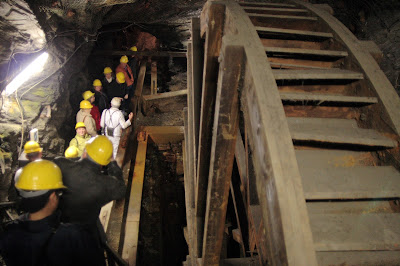Red Baron
had been to Goslar several times, but during the
Museumsreise 2015, we visited two sites I had yet to see. One was the
Rammelsberg, i.e.,
the mining activity in and outside; the other was the
Kaiserpfalz (Imperial Palace).
The
Rammelsberg houses an ore mine that has been operational for over
1,000 years. Tracer analysis of archeological samples unearthed as far away as
England shows that copper from the
Rammelsberg mine dates back to the 3rd
century AD. The mine eventually closed in 1988.
We continue to read in Wikipedia:
The ore deposits at the Rammelsberg were caused by the escape of hot,
metal-bearing, thermal springs on the seafloor in the Devonian period. This
formation is referred to as a sedimentary exhaustive deposit. At the bottom of
the Devonian sea, two large lenses of ore were formed that were later caught
up in the folding of rocks during the Carboniferous period and so lie
overturned at an angle in the mountain where they reach the surface.
One of the main mining problems, particularly in the Harz mountains, is
groundwater entering the galleries. When the mining galleries' floor reaches
levels well below the earth's surface, it becomes necessary to pump out the
infiltrating water. In the absence of electricity, the miners installed giant
overshot waterwheels underground to operate the required water pumps.

|
|
Giant underground waterwheel (©Wikipedia/pipmaru)
|
The wheels were driven by water collected in special higher-up ponds. The water
was guided in dedicated water galleries to and from the waterwheels' site and
finally released into the valley.

|
The old water galleries of the Röder mine our group walked through
were
relatively narrow and sometimes somewhat low
|

|
|
Red Baron's safety helmet clearly shows traces of his head hitting the ceiling. |
In the meantime, the Rammelsberg mine has become an archeological site. It
started in 1999 when a shoe was found on-site, dated 1024. In 2011 archeologists
dug out a wooden construction identified as Europe's earliest mining
gallery supported by wooden pillars and beams.

|
|
Archeologist Dr. Klappauf standing in front of his excavation
|

|
Painting in Goslar's Municipal Museum: Dr. Klappauf treading the
bellows
of an artisanal smelting furnace. This archeologist has recently dug out
a few thousand smelting sites in the Harz region dating as
far back as the Middle Ages.
|
Goslar's other highlight, the Imperial Palace, is strongly connected with the
mining activity at the
Rammelsberg. In 1005, attracted by silver, King
Henry II
had his
Kaiserpfalz built at the foot of the mountain. It comprised a
vast complex of buildings, including a large abbey church containing an Imperial
Throne and the so-called Krodo Altar, both made from bronze in the second half
of the 11th century.

|
|
The renovated Kaiserpfalz in the 19th century
|
Already in the middle of the 13th century, the Imperial Residence buildings
started falling into ruins. Eventually, the church was reduced to just one
entrance hall. However, the ill-fated alliance of the throne and the altar in
German history ended neither then nor with the Reformation. On the contrary,
Luther's Church needed and sought the support of the territorial princes not
only against the Catholic Counter-Reformation but against Protestant heretics
too.
In the second half of the 19th century, Goslar's Prussian rulers had the
Imperial Palace reconstructed as a national shrine. They accelerated the building
activity following the foundation of the 2nd Reich in 1871. Hence the former
Kaisersaal is decorated with wall paintings commemorating events in
German history. Again, Luther's Reformation is one of the key events for
Germany's "Prussian" north.

|
|
Luther in Worms: God help me, Amen
|
However, the centerpiece of all the paintings is the apotheosis of the
Kaiserreich (Empire), dated 1875.

|
|
Apotheosis of the 2nd Reich (©Wikipedia/Jim Steakley)
|
It shows the "new"
Kaiser Wilhelm
on horseback, followed by his son
Friedrich, who in 1888 was emperor for only 99 days. The later
Wilhelm II, Friedrich's son, is depicted as a boy on the right-hand side in a blue
uniform in an awkward pose partly covered by the pillar, perhaps to hide his
crippled left arm? In such an allegoric painting, you expect
Bismarck to stand with
General Moltke, the former hammering on the new Reich's cornerstone. The presentation is
crowned by, among others,
Emperor Barbarossa
and Prussia's Joan of Arc
Queen Louise, pointing to her son Wilhelm, the new emperor. In front of the painting, you
will recognize Dame Germania and Father Rhine with the Alsace's annexation, now
Germany's river and no longer Germany's border.

|
|
Wilhelm's equestrian statue in front of Goslar's Kaiserpfalz
|
In vain, in the late 19th century, German nationalists tried to elevate the
first emperor of the 2nd Reich, surnaming him the Great.

|
|
To look at the Imperial Throne, you must visit the
Kaiserpfalz ...
|

|
|
... the Krodo-Altar nowadays is on display in Goslar's Municipal
Museum ...
|
... so eventually, the throne and the altar became separated.
*











No comments:
Post a Comment